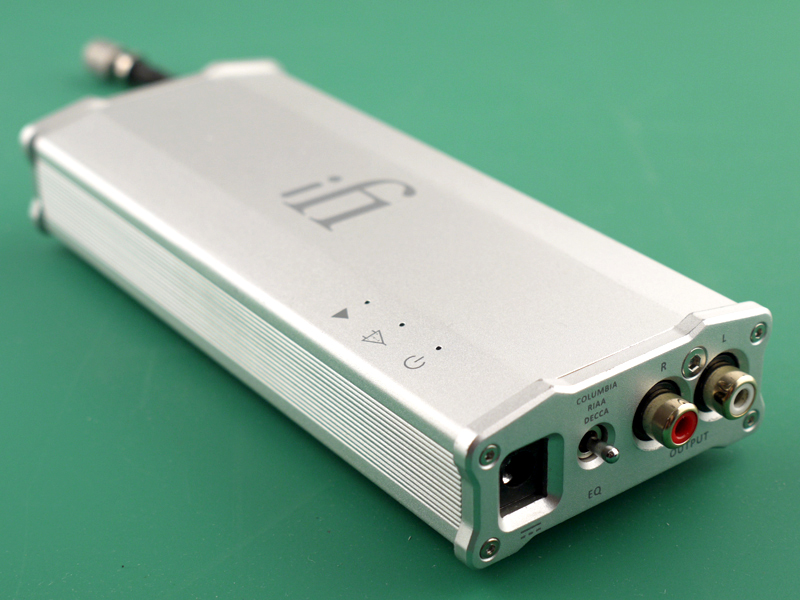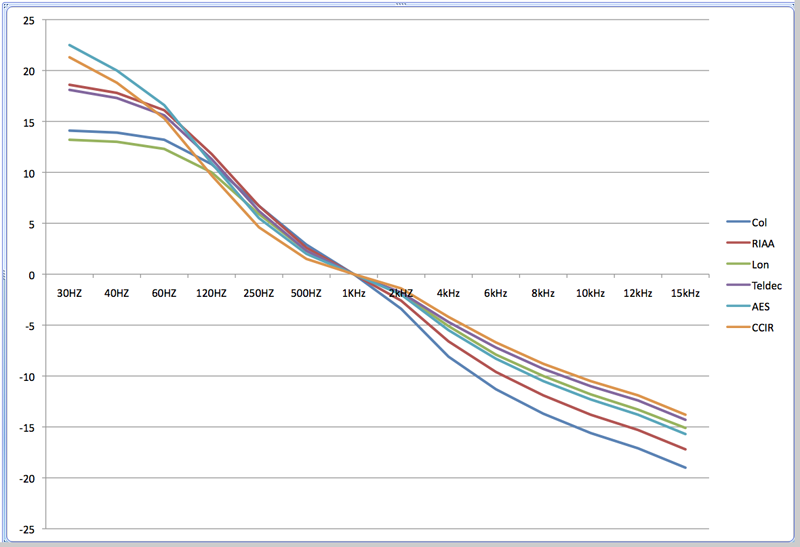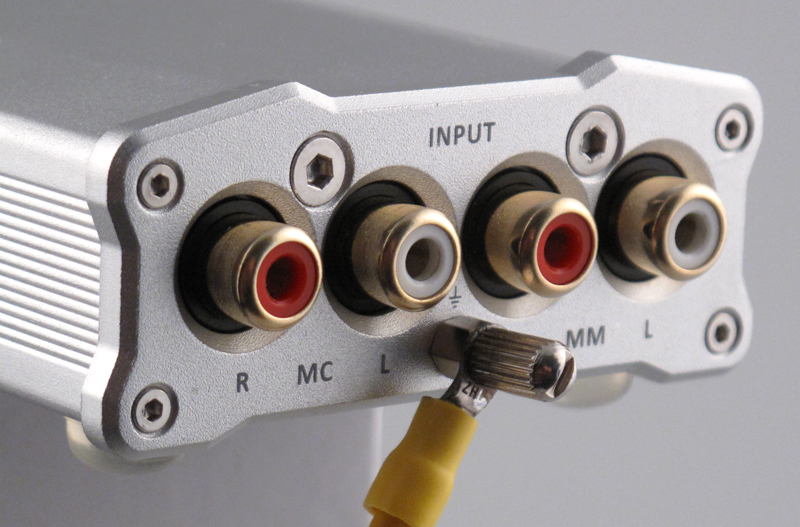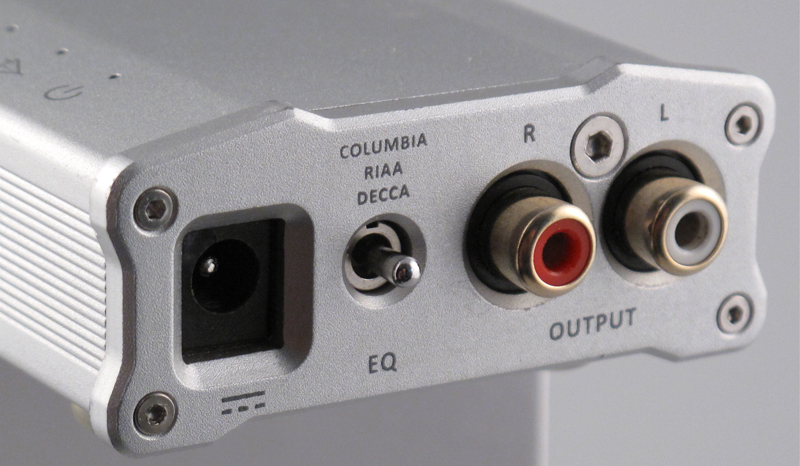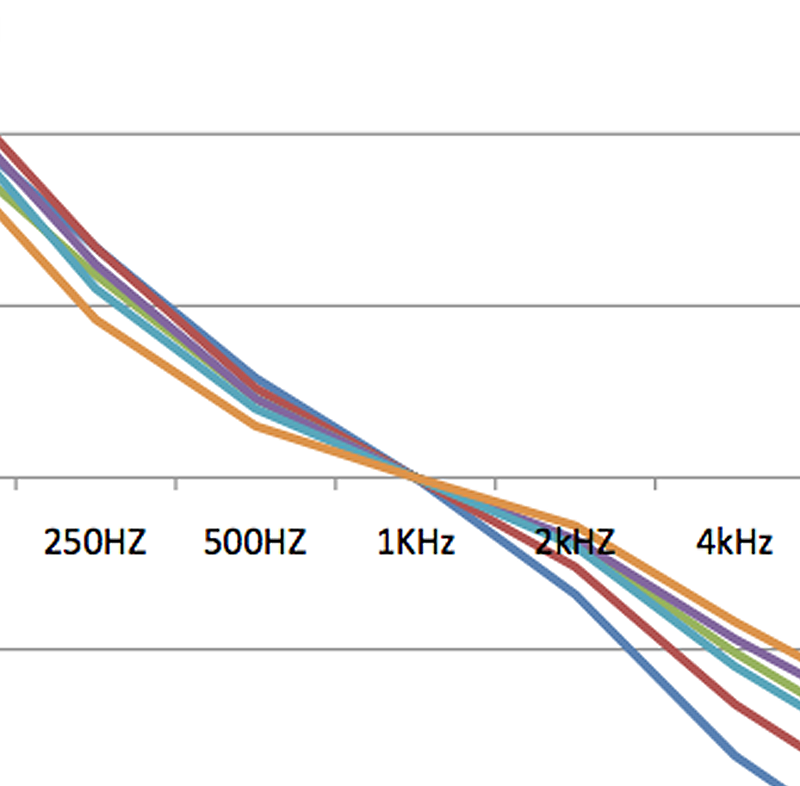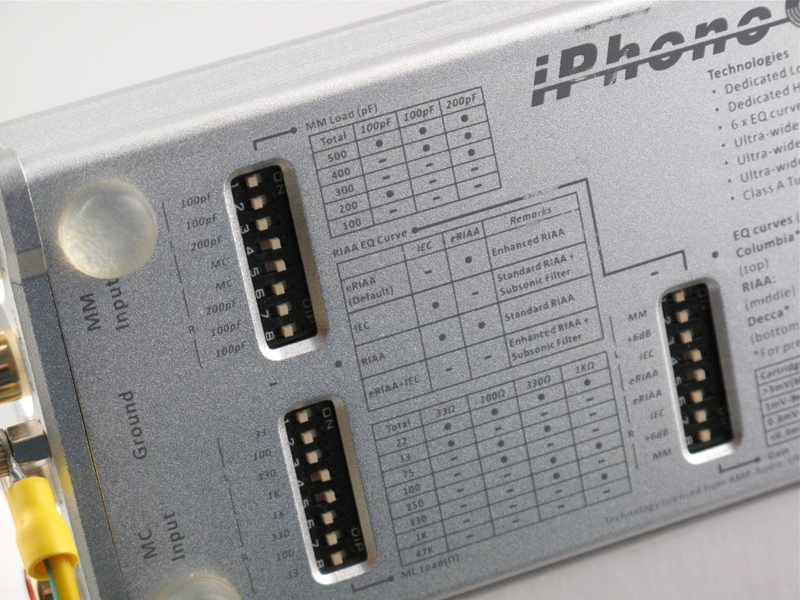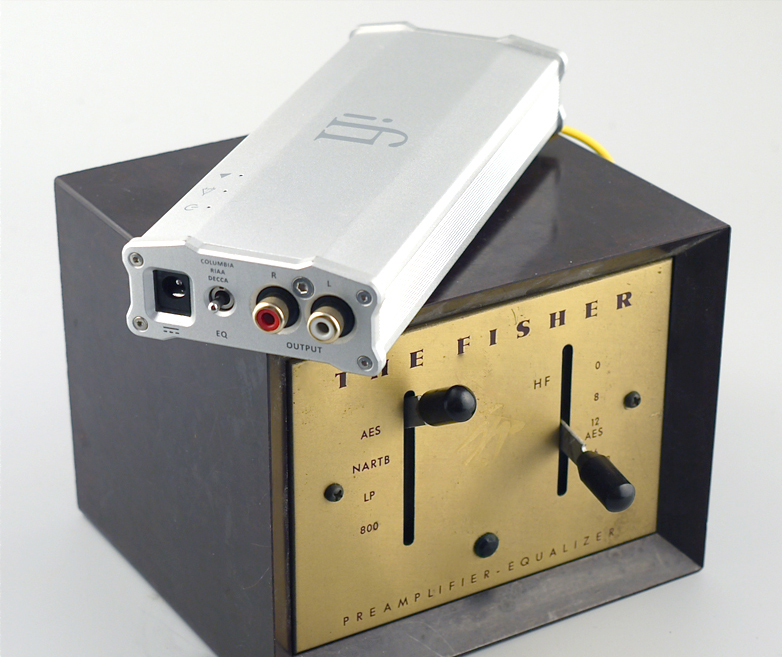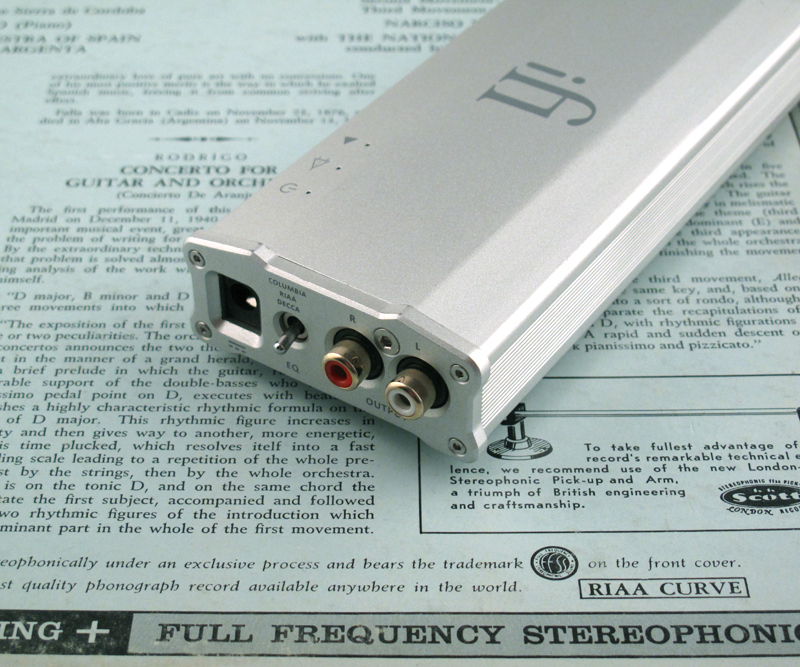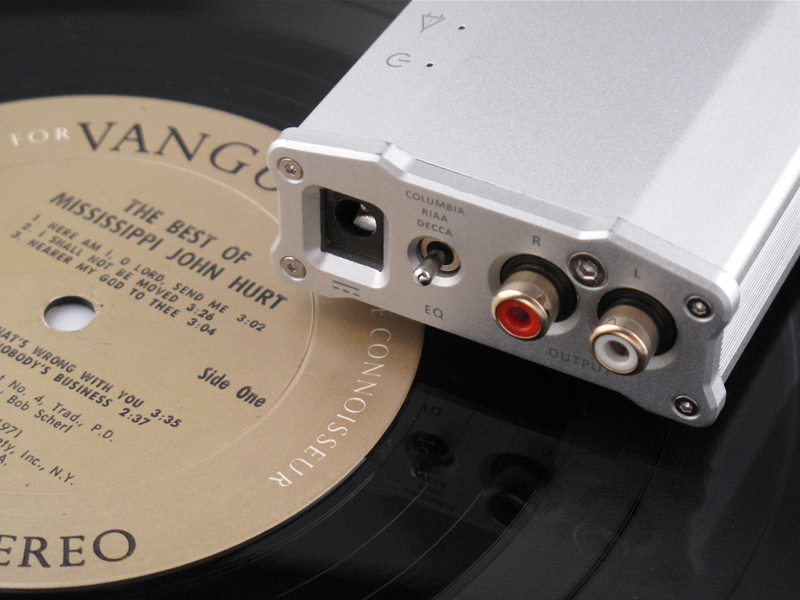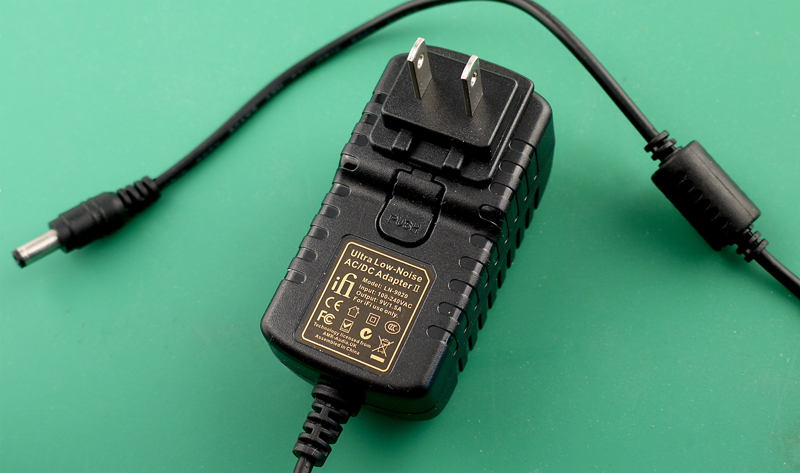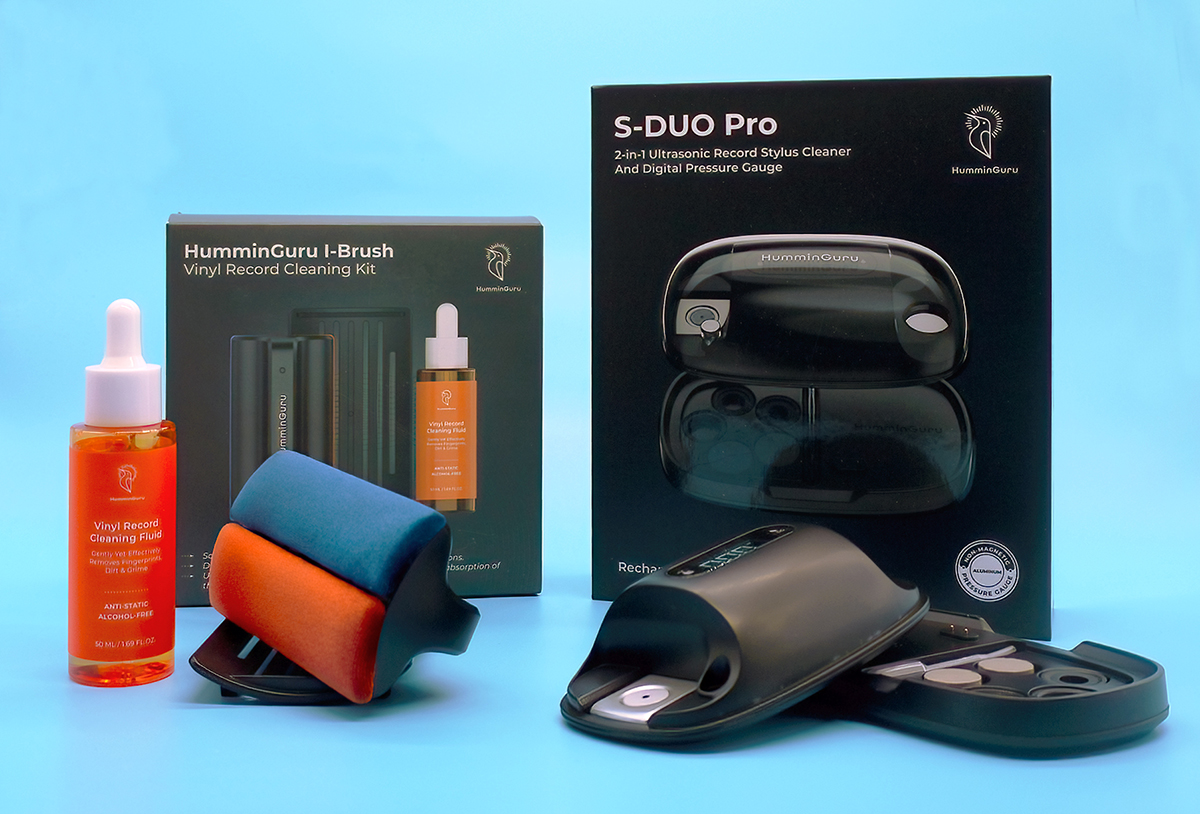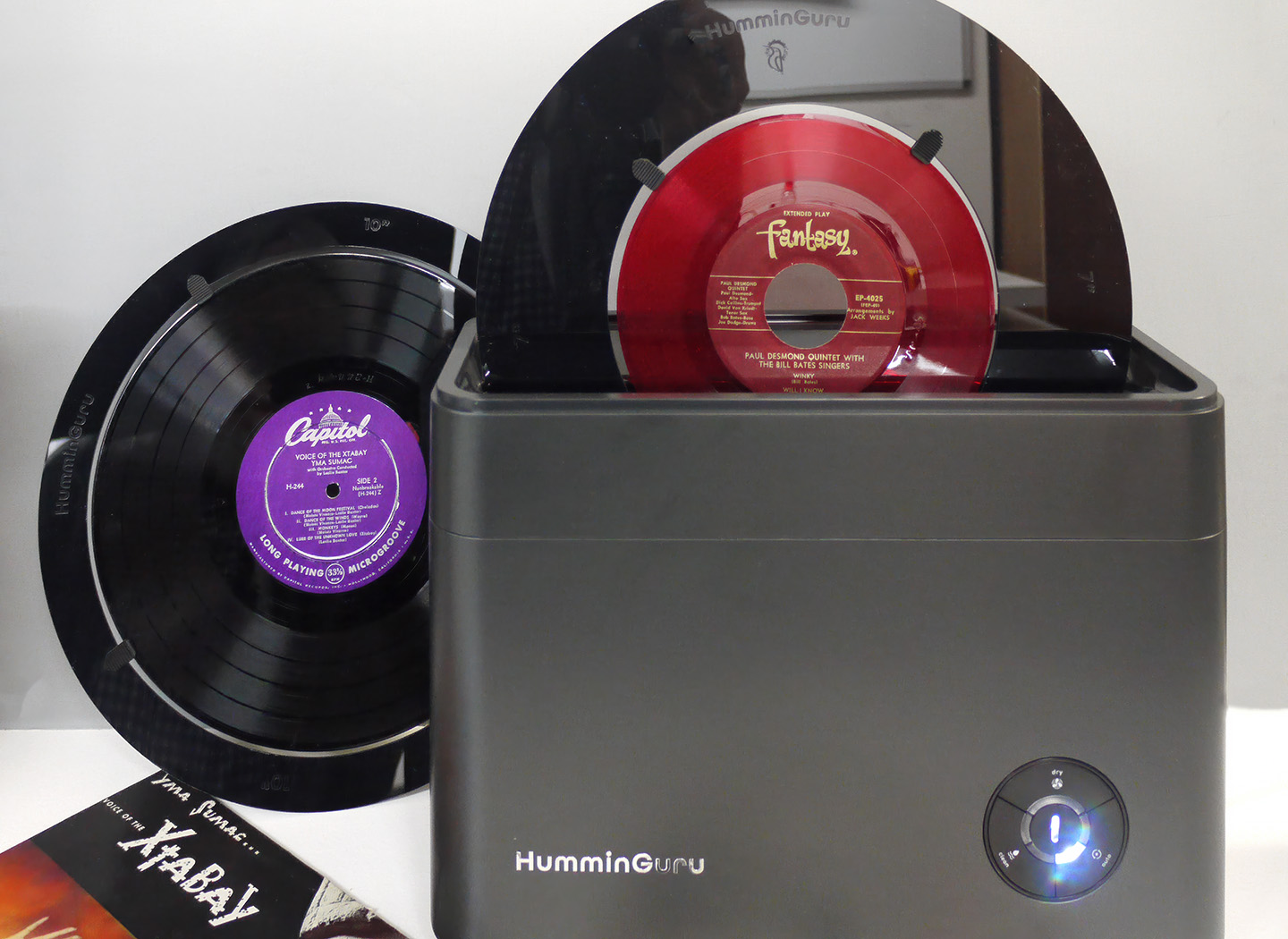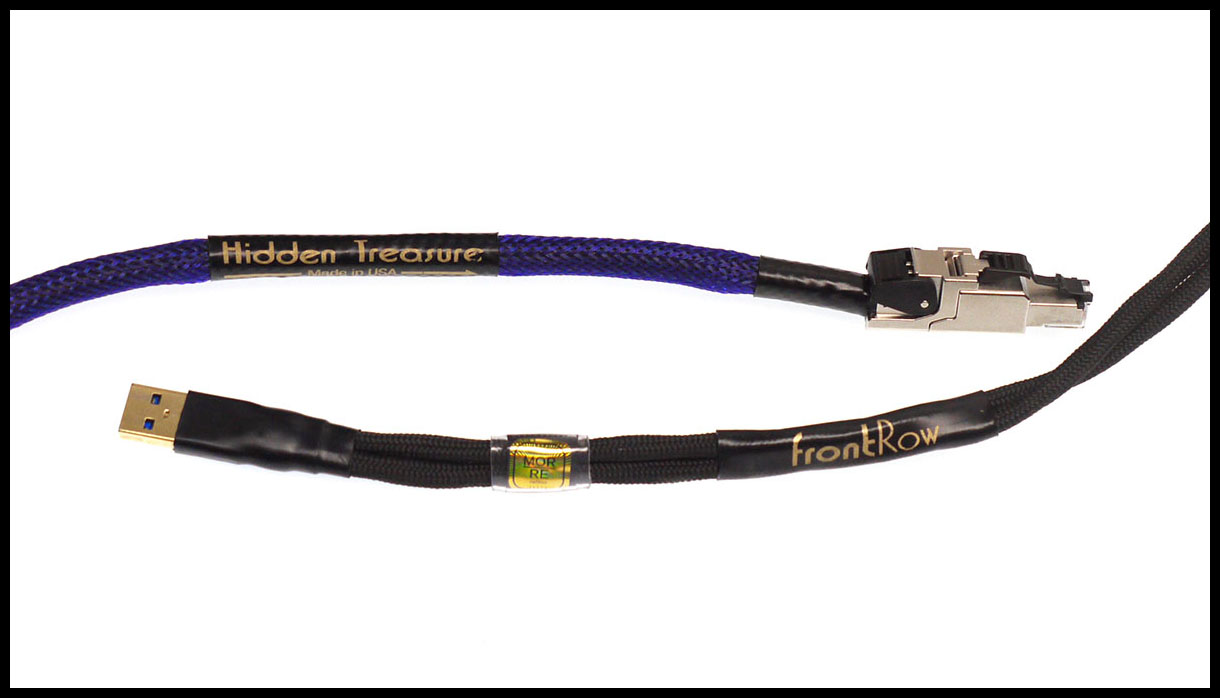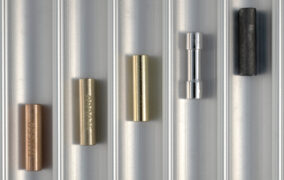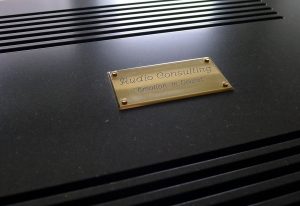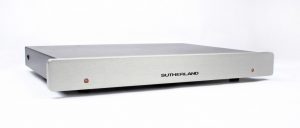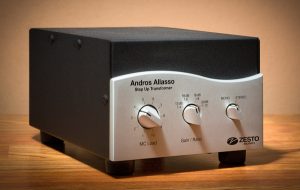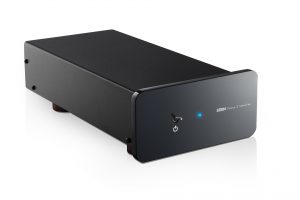If you have followed the trending audiophile markets for headphone amps and DACs, you've probably stumbled across the iFi line of shiny, pocket-sized electronics much as I did. iFi is the budget brainstorm of UK high-end audio firm Abbingdon Music Research, gear designed in the UK, manufactured in China. The various products share extruded casework and often boast features not found in competing products. With the passing of Steve Jobs, the acquisition of Beats headphones, and the iTunes disregard for high-resolution audio, there may be no audiophiles left in Cupertino to notice the iprefix on these small electronic devices and unleash the legal pit bulls. Or perhaps ex-Brit Apple industrial designer Jonathan Ive just explained that much of the UK public still pronounces "Hi-Fi" without the H.
What caught my eye was not the DSD iDACs, but the iFi Micro iPhono, a compact MM/MC phono stage released a couple of years ago to quite positive reviews-although many of them ignored the feature I find most intriguing. If you are here just looking for a cost-effective way to play all the latest reissues from Acoustic Sounds or Music Direct, you can skip to the last few paragraphs for my thumbs up. If you prefer listening to original pressings, however, your curiosity might also be piqued by a tiny switch labeled Columbia/RIAA/Decca on what passes for the iPhono's front panel, so stick around for the long-playing version.
The Recording Industry Association of America may be best known to post-analog music consumers for their legal efforts to limit/commercialize digital file sharing. That's because the RIAA was first organized in 1952 to administer copyright fees…and also to set technical standards within the industry. By 1952 the transition from the 78 rpm era to the age of the LP was well underway, Columbia Records having introduced the 33 rpm "microgroove" vinyl LP in 1948. Unwilling to license their rival's process, RCA countered with the 7" 45 rpm disc in 1949, just one of many "format wars" before and since. While the 45 "single" became the standard for pop releases, major industry players Capitol Records and US Decca issued LPs in 1949. RCA relented and issued their first LP in 1950; Deutsche Grammophon and Melodiya began in 1951; UK Decca in 1949, EMI in 1952, and so on.
Naturally, there were problems. First, keep in mind that grooved disc recordings are not actually "analogs" of the original source. If that were true, the groove modulations for low bass sounds would resemble large subwoofer excursions, and high frequency tones the microscopic movement of a tweeter, inaudible above the "surface noise" of the disc. So (and I do over-simplify here a bit), in the mastering process bass information is reduced in level by an electronic filter network to make the groove modulations smaller, and treble information is increased in level to keep it above the groove noise. A third filter is sometimes added to limit the bass below 50 or 100Hz. In playback, bass information is boosted and the treble reduced to provide a "flat" response; this is referred to as "equalization" or "EQ curve". Of course, "equal" would be true only if the recording and playback curves are mirror images of each other.
All the major LP producers (and many of the minor labels) had also issued 78s. Many had developed proprietary equalization curves (which drives 78 rpm fans batty to this day), and of course continued thus when along came the LP. Columbia modified the existing NAB (National Association of Broadcasters) EQ curve for their LPs. Others used the AES (Audio Engineering Society) recommended curve. In the UK, Decca's FFRR EQ had at least 3 iterations. Which thereby all sounded different in playback unless the playback EQ was a match. In 1954 the RIAA entered the fray, and proposed what has since been known as the RIAA EQ curve, as a "universal standard". Ironically, it was based on the RCA "New Orthophonic" EQ of 1952, significantly different from the Columbia, NAB, or AES curves. That is why any vintage integrated amp or preamp from the 1950's will have multiple options for phono EQ, and tone controls.
There is a helpful tabulation of various 78 and 33 rpm playback EQs online at www.vinylengine.com for the curious. The RCA column is essentially RIAA, so it is easy to see response differences at say, 120Hz and 10,000 Hz. For example, a recording made with Columbia EQ, but played back with RIAA EQ will sound about 2dB too bright 6kHz to 15kHz. It will have 1 dB of excess upper bass at 120Hz, but will be 4dB bass heavy at 40Hz. A dB or two of local variation is easy to forgive in a loudspeaker, but phono EQ errors broadly affect midrange as well as treble and bass, and are quite audible on an otherwise neutral system.
Here are the important LP replay EQ curves from the vinylengine.com table in graphical form (not on a true log scale, I realize, but to help visualize the relationships). For clarity, I've omitted the NAB; it is the same as Columbia above 1kHz, and close to AES below. Most obvious is the different degrees of bass boost; clearly, Columbia EQ (blue) expects less boost than RIAA (red) provides, while AES (teal) expects more. The treble curves are similarly divergent, with Columbia EQ expecting the most high frequency rolloff-and more that RIAA provides. If a given early LP sounds thin, bright or boomy to you, this may be why.
Tracking down the right EQ for a vintage LP can be tricky, as many labels used more than one EQ over time. Online sources depend on near-archeological information found on runout groove deadwax and jackets, in pre-amp instructions, occasional articles, and personal opinions, so there is some disagreement. Hey, it's the Internet. The available information is skewed towards classical music labels manufactured in the US-that's what most US audiophiles listened to in the ‘50s, and High Fidelity magazine published a "Dialing Your Discs" table monthly lsting the various EQs needed by label. Other genres and European labels remain largely terra incognita. However, the major classical players (RCA, Columbia, EMI, Decca, etc) mastered and/or pressed pop/rock/jazz as well as classical LPs for many other labels in addition to their own product. But there were also countless independent mastering shops as well, using whatever EQs they chose.
Googling about for pre-RIAA curve information, I have found Columbia EQ recommended for: Allegro, Bach Guild, Bartok, Boston, Cetra-Soria, Columbia, Concert Hall, Dial, Epic, Festival, Folkways, Haydn Society, HMV, London, London International, Lyrichord, Music Treasures, Nixa, Oceanic, Oxford, Rachmaninoff Society, Renaissance, Stradivari, Tempo, Urania, Vanguard, Vox, Westminster.
I have found AES EQ recommended for: American Recording Society, Bartok, Blue Note, Brunswick, Capitol, Concert Hall, Contemporary, Coral, Decca (US), Dot, Elektra, EMS, Esoteric, Good Time Jazz, Mercury, Nixa, Nocturne, Pacific Jazz, Philharmonia, Riverside, Urania, Vanguard, Vox, Westminster.
I have found NAB EQ recommended for: Atlantic, Audio Fidelity, Audiophile, Bach Guild, Capitol, Colosseum, Contemporary, Coral, Decca (US), EMI-Angel, EMI-HMV, Good Time Jazz, Lyrichord, MGM, Nixa, Overtone, Period, Polymusic, Remington, Tempo, Vox.
The RIAA curve was initially an American standard, with uneven impact outside the USA until the stereo era when European recording labels widely began to adopt the RIAA equalization-without crediting the organization. UK Decca's LXT 5346, a mono LP from the mid-50's, for example, was a test record of calibration tones for RIAA EQ, not their earlier proprietary FFRR, as it had presumably become the UK "standard". Of course, even after officially agreeing to implement the RIAA equalization curve, some labels may have continued to use their own preferred equalization. Columbia is one such prominent suspect in the USA, as are Decca/London, Teldec/Telefunken, Deutsche Grammophon, and the Eastern Bloc (Melodiya, Muza, Supraphon, etc.) You will rarely if ever find a UK/European LP that actually specifies RIAA EQ.
Over time, collectors have come to discern certain clues to help ID pre- versus post- RIAA LPs. For many labels, "pre" deadwax inscriptions are larger and raised versus smaller and engraved characters "post". For RCA labels, its "Line Dog" pre versus "Shaded Dog" post. Mercury 4000 series are pre, 5000's are RIAA. UK Decca/London LPs remastered for RIAA will have an "R" after the matrix number. For Columbia, "6-Eye" labels are a rough boundary. Blue label Columbias with a Hi-Fi+ jacket sticker should be RIAA. No, I haven't figured out Blue Note yet.
The controversy persists in our standardized and regulated world because LPs from different labels, countries, and time periods do sound different-often in consistent ways, disc after disc; because reissues sound different than originals; because LPs can sound different from reel tapes from the same masters. No double-blind testing needed. Trust me. It's obvious. The question of why all this is so has many possible answers, and phono EQ is one aspect that can be directly addressed by providing alternate options for playback.
There are other factors to consider as well. EMI and Decca, for example, both recorded the same London orchestras in the same halls over the years, but with different engineers, mic set-ups and electronics, so the results sound quite different. I recall the golden days of TAS, where it became clear one could balance a high-end system for RCA's LPs, or Mercury's, but not both-even though RCA pressed the preferred FR generation Mercury discs. American and European firms used different cutting lathes and electronics, different acetate and vinyl formulations, etc.
The reality is that few records are (or ever were) actually mastered "flat" using only the standard RIAA (or other) EQ. The mastering engineer would inevitably "sweeten" what the artists and recording engineer approved until the mix sounded best-in his room, on his speakers, and to his own ears-with a bit of fudge added in mixing bass to mono, riding gain, damping cutter head resonance and "squeal", changing groove pitch, etc. as needed. That is why collectors of vintage LPs peruse the deadwax runout grooves and ascribe guru status and serious market value to the Rudy Van Gelder, and George Piros inscriptions. For an audiophile example, Stan Ricker was famously instructed by the head of Mobile Fidelity to master their reissues several dB hotter in the treble than RIAA specified.
As to RIAA heresies, Analog guru Michael Fremer says "B.S"; colleague Herb Reichert disagrees. Of course, before the proliferation of $50 audiophile reissues, Michael routinely commented on the sonic differences between US and European pressings, and Herb still likes vintage vinyl. And it is also true that modern UK/Euro phonostages are more likely than US designs to have alternate EQ settings-Abbingdon Music Research among them. And most are pretty expensive.
Which brings us back to the iFi Micro iPhono, which is not. It is indeed roughly the size of an iPhone 6 (actually about four stacked) and is shipped in an Apple-style white box, but rather than being a sleek slab, it has the more prole-looking cross-section of a bicycle pedal. There are 2 sets of RCA inputs (MC and MM) so crowding one end that the ground lug needs a pigtail for access.
The output RCAs are on the "front" along with the connection for the wall-wart power supply, along with that cute little switch marked Columbia/RIAA/Decca that allows the user to select alternate EQs on the fly.
Ah, would that it were ever so simple. If next few paragraphs seem a tad confusing, there are at least two reasons. First, keep in mind that iFi's recommendations are inherently UK-centric, and may need translating for non-UK sourced LPs. For example, while Columbia (US) invented the LP, there was also a UK EMI/Columbia, as well as German, Spanish and probably other "Columbias" often not related to the US outfit (the famous "Decca/London" Argenta LPs were sourced from Spanish Columbia, for example). Similarly, there are US, French, German and probably other "Deccas" as well as the UK breed. Second, it really is confusing. An itty-bitty phono stage can't be expected to rationalize what 100 years of war and corporate wrangling have wrought.
iFi recommends the Columbia EQ position for "most pre-1980" Columbia, Epic, and EMI ("records released under Columbia")-by this I assume they mean US Columbia mono releases, including EMI material (Lipatti, Gieseking, etc.). However, my understanding is the early UK EMI HMV and UK EMI/Columbia monos (including the UK pressings used by Angel in the US) were also done with the Columbia or close relative NAB EQ. Let your ears decide.
iFi recommends the Decca EQ position for "most pre-1980" Decca, London, Argo, EMI, DGG, Archive, etc., and NAB. The latter might seem wrong, as Columbia EQ is a variant on NAB, but the main difference is in the low bass. NAB wants a boost on playback, Columbia a cut vis-à-vis RIAA. So this is a tonal balance improvement over RIAA, but not an accurate EQ. I'd add AES LPs to the list here with the same qualification; they sound bright basically because they expect much more bass boost that RIAA provides.
iFi recommends RIAA EQ position for all post 1980s LPs and "some after 1950's". Perhaps this is true in the UK, but from the US market perspective, this is just wrong, of course; the RIAA standard was widely adopted stateside by the mid ‘50s (including by AES and NAB/NARTB). The March 1954 High Fidelity magazine reported (my parentheses and elisions):
"…Capitol…shifted to the new curve (from AES) last summer …Westminster, likewise without announcing the change, adopted the new curve in early autumn. Mercury was still on (AES)…and when they would change…had not been decided. …According to Columbia's top engineer…Columbia intends to make the change to the new curve "gradually" He did not amplify nor explain. …London's curve almost matches the (RIAA) but for the fact that its treble boost (and thus rolloff on replay) is only 10.5 dB at (10kHz, as opposed to 13.5 dB with RIAA)."
Elsewhere, the article notes the curve mismatch tolerance at the time was 2 dB; most audiophiles would find that unacceptable today. Modern High End phono stages can track RIAA +/- .1 dB or so.
iFi makes no suggestion when it comes to Philips, Asian, or Eastern bloc classical labels, or pop/rock/jazz labels at all (Parlophone? Island? Verve? Blue Note? WTF?). Neither do they publish their EQ curves, but Stereophile's review of the parent company Abbingdon Music Research's PH-77 phono stage includes their measurements - thanks, JA! Let us assume for the sake of argument that the iFi curves resemble the AMRs.
iFi does makes some more general suggestions that transcend label specifics. For example, they recommend the Decca setting for LPs that sound "too bright, edgy, thin, lacking in scale or body" with RIAA. While at first that just reminded me of an ex-girlfriend, judging from the AMR curves they apparently mean a progressive cut above 1kHz reaching about -2dB at 15kHz, and a nearly 1 dB mid bass boost centered around 200 Hz. Any LP played on Decca will sound a bit warmer and less shrill. However, I cannot find a published Decca/London EQ table that requires a treble roll-off greater than the RIAA, so this may be a proprietary EQ curve.
iFi recommends the Columbia position for LPs that sound "both too bright and with muddy overblown bass" with RIAA. By that they mean a slight lower mid boost, then a progressive reduction of bass below 250Hz reaching-4.5 dB at 30Hz, and again a -2 dB high frequency cut. This is basically consistent with published Columbia curves. Any LP heard on Columbia will sound less boomy and harsh.
Let's face it: we all have records that could do with a bit of one or the other, regardless of label. It should be emphasized that playback EQ options are not "tone controls" per se; conventional bass/treble tone controls cannot substitute for proper EQ. All LPs have EQ introduced in the mastering process, so all need replay EQ. The problem is finding the best fit for the inverse playback curve. Although the greatest audible changes are at the frequency extremes, because the treble rolloff and bass turnover hinge points vary (1590 to 3180 Hz, and 400-800 Hz for example-each an octave range), and as the slope is typically a gentle 6dB/octave, the midrange is affected differently by each EQ, as are the perceived micro-dynamics and ambience cues that abound in the midrange. This is presumably partly because the mastering EQ curve introduces phase shifts that are only cancelled with the proper curve, adding to the "rightness" of the result. Here is a close-up of the midrange variations in the vinylengine.com curves-note how the treble roll-off curves diverge quickly above 1 kHz, and the lower mid-upper bass curves seem laterally shifted due to the different rolloff/turnover fillter hinge points.
Although I think iFi and Abbingdon overstate the case for non-RIAA pressings lasting into the stereo 70's, the iPhono lets the listener decide-there's obviously more flexibility here than the typical phono stage, especially as one can also tweak the high frequency response by changing the cartridge loading. To do that, one just turns the iPhono over. That's where they put the complicated stuff-mini switches for resistive loading for MC (22-1kOhm + 47kOhms), capacitive for MM (100-500pf), and gain (40, 46 for MM 60, 66 dB for MC) settings.
Then there is a set of DIPs for modifying the RIAA EQ set on the "front". Turns out there are some modern variants on the classic 50's RIAA. "Enhanced" eRIAA is the default, and adds correction for European Neumann cutting head non-linearity at ultra high frequencies. Some think that irrelevant-but also be aware that the RIAA curve was reportedly modified in 1974 to limit response over 22 kHz (there's a Red Book trivia question lurking there). IEC RIAA adds a subsonic filter (which many think just more regulatory foolishness, but it can free a low-power amp from having to waste watts woofer-wise). In some systems, either or both can clean up the frequency extremes. The switches are labeled with miniscule lettering on the silver casework; a folding card illustrates the options with IKEA-style pictoids, but there is no explanatory text other than a 4-page "Quick Start" manual. The switches are recessed and tiny, but iFi kindly includes a mini screwdriver for flipping them. As the iPhono only weighs about 9 oz, attaching the required 6 cables can leave it suspended in air-and awkward to turn over. As I wanted to explore the EQ and loading options, I left it in the missionary position with some felt pads on the "top". I set it for traditional RIAA, for 66dB and 1k Ohms or 47K Ohms for my Myajima Zero mono cartridge, switching to 60dB for the Lyra Delos stereo cart. And of course played around with the switches.
I have the two cartridges in separate arms on my Nottingham Analogue Spacedeck turntable; as the Delos normally runs balanced into the AQVOX 2CI phono stage, I have for years run mono carts (I had Grado and Denon monos before the Myajima) into a second "budget" phono stage-at first, an original 50's mono Fisher 50-PR MM phono stage ($5 at a yard sale), then a Lehmann Black Cube, or a Creek OBH-15 (both roughly comparable in price to the iPhono).
I have lots of mono records. Until I was out of college, I had neither space nor funds for stereo-which means I first heard Heifetz and Horowitz, Baez and Dylan, Monk and Mingus, and the Beatles and Stones in mono. I've been a record collector ever since, and as my interest in music deepened, I realized how essential mono-era music was in the scheme of things, and that it is often found at a fraction of the price of stereo. Plus, as stereo cartridges and styli improved, they became less suited to playback of less than pristine mono LPs-even when electrically summed to mono. This is basically because mono is recorded with lateral groove modulation only, and stereo requires both horizontal and vertical modulation. On a mono LP, the only vertical modulation comes from scratches and pressing bubbles. A stereo cartridge strews any surface noise around the room; a mono cart ignores much of it. As I write this I am listening to an old Angel LP (EMI pressing) of legendary violinist Johanna Martzy playing Bach. The disc looks pretty trashed, and sounds that way with the Delos; with the Miyajima (yes, through the iFi, less than a quarter of the Zero's price), the surface noise is much reduced, and the performance is riveting. I can tell you right now Martzy sounds most marvy with the toggle on Columbia, her fiddle a bit more "viola-ish" on Decca, and comparatively thin on RIAA.
Similar benefits were heard as I plowed through the mono shelves, flipping the EQ and loading switches as my ear told me to. It was fascinating to hear Haskil and Grumiaux come alive on Epic, or Francescatti and Miles Davis on Columbia, Leadbelly on Folkways, Lester Young on Charlie Parker, June Christy on Capitol, on and on. The Miyajima is a great mono cartridge, and the variable EQ iFi made its splendors obvious in ways an RIAA-only phono stage never would.
The main omission of the iFi menu from the US perspective is the absence of AES EQ, the primary alternative to Columbia/NAB EQs and RCA's New Orthophonic in the pre-RIAA years. The Decca setting, while not perfect, can bring an ensemble back into a more listenable balance than RIAA does. The iFi iPhono lets you tweak a given disk to personal preference, and there are surprises to be found behind all three EQ doors.
What's it sound like, dammit?
Having spent lot of time relishing the iPhono's flexibility with the Miyajima Zero mono cartridge, I almost had to force myself to shift it over to modern LPs and stereo. Leaving the iFi set to RIAA, 60dB, and 1K Ohms, I was able to compare it to the other phono stages I had on hand. Most are no longer in production, but were highly regarded in their day. For such comparisons, I have two phono cables, one with RCAs, the other XLRs (for the AQVOX), otherwise identical.
First, the Creek OBH-15 has always been thought of as very capable performer at its price, yet the iFi left it in the dust. By comparison, the Creek sounded thin, a bit coarse, and much less dynamic. The Lehmann Black Cube (the original version, there have been several updates) met a similar fate. The iFi also sounded both cleaner and smoother than the black box, with much wider, deeper and better-defined soundstage. Musical instruments had more natural timbre, transient attack and release, and body than with either of my older budget faves. Not to forget mono, I also pulled out my pre-RIAA era Fisher multi-EQ mono tube phono stage that had sounded pretty decent with my Denon DL-102. Even with step-up transformers that alone cost more than the iFi, the Fisher sounded tube-sweet but dynamically constricted, and there is some irreducible low-level tube noise and hum, S/N ratios having improved a fair bit over the decades. The iFi, by contrast, was dead quiet, lively, detailed and, well…modern sounding. The mono "image" was much tighter but with a better sense of depth with the iFi than with the Fisher, too.
Finally, I had to test iFi's assertion that pre 1980s stereo LPs would benefit from non-RIAA equalization. Out came the Bluebacks, 6-Eyes, Widebands, Tulips, Melodiyas, and Teldecs. In some cases, like London CS 6046, a 2E/3E FFSS pressing of Rodrigo's Concierto de Aranjuez with Yepes/Argenta (yup, one of the Spanish Columbia recordings), the answer is unequivocally yes!-and this despite the (US printed) Blueback jacket clearly labeled RIAA. Decca engaged, a reduction of the usual "early London" stridency I expected. What I didn't expect was how dramatically the soundstage opened up as a wider, deeper, continuous space. That it sounded "more like a RCA" is one way to put it, and RCA Shaded Dogs are RIAA done right. So you can believe your eyes or you can believe your ears.
Other early FFSS Londons, also labeled RIAA, same thing. With most later London issues other than the Phase Four series I stuck with RIAA. A similar pattern with older and later UK and German Deccas (which unlike the London versions, were never identified as RIAA). Early EMIs (including EMI Columbia SAX) were also improved with Decca. Likewise with early Telefunkens, where the early music revivalists gained some welcome warmth. Some shrill Deutsche Grammophon LPs sounded better with Decca, but with others, like DGG 138 755, Tulip pressing, the Dvorak Cello Concerto, with Fournier & Szell, not so much. In RIAA, the massed high strings have a just bit of glare. With Decca that may go away, but the bass becomes lugubrious, and even the cello loses luster.
For US product, we are definitely in EQ-as-tone-control territory. Decca could be transformative on Mercurys, especially those pressed by the Columbia Record Club, actually (the too-cheap-for-eBay ones with CTRFR etc. in the deadwax). Early Columbia/Epic LPs were a mixed bag, all three positions came in to play. Some of the notoriously bass-shy Szell LPs wanted Decca, while some Ormandy's liked Columbia but with Glenn Gould I mostly stayed with RIAA. Decca was also useful with many early digital and DMM discs that tend toward brightness. Finally, Decca came in handy with several "hot" audiophile reissues from Mo-Fi and Classic Records. I did not choose Columbia anywhere as often with stereo as with mono, but then I like bass.
My jazz, rock, and folk stereo LPs are about a 75/25 mix of US and UK/Euro pressings, and for the most part, I preferred post 1980 LPs in RIAA, if only because I "learned" the performances that way, and my system has been tweaked to suit. ECMs have a "house sound", for example, that I won't muck with. As most rock albums are purposely mixed for a specific "effect", slashing highs and crunching bass are just part of the experience. I tended to use the EQ switch as a subtle tone control, Decca to take the edge off here or add warmth, Columbia to cut back excess bass, but I didn't notice any overall pattern-with so many labels and pressing variables, it's a case-by-case proposition. I do have a number of pre-1980 recordings in both US and UK/Euro pressings, and the iPhono effortlessly highlighted the differences. For example, Simon & Garfunkle's 1970 Bridge Over Troubled Waters on US Columbia KCS 9914 (red 2-Eye label, 1K stamper-so not an early pressing) sounds best with RIAA, worse with Columbia… but the UK CBS 63699 (orange label, B1 stamper) is altogether superior in every respect, and especially with Decca. One hell of a recording too-all hail Roy Halee!
I found vocal recordings to be particularly revealing of the iFi "EQ" effects. For example, with Cat Steven's Tea for the Tillerman (UK Island ILPS 9135, 1970) I preferred Decca on most but not all cuts; by the way, the iPhono also easily distinguished between my "Pink" and "Palm" label pressings of this audiophile classic. Carmen McRae Live at Sugar Hill (Time S/2104, 1964) can (and maybe should) sound a bit forward and bright with RIAA, but Decca subtracted too much high frequency air, impact and cymbal shimmer (and all the electricity of a live performance) and Columbia also killed the bass. Vanguard VSD 19/20,The Best of Mississippi John Hurt was an opposite case. It documents a 1965 solo concert at Oberlin College by the legendary bluesman, presumably from the PA feed-typically that would be from one mic for the vocals, another for the guitar. Because of proximity effects from close miking, the result is Hurt's signature finger-style guitar almost overwhelmed by booming bass strings and over-sibilant vocals. Columbia to the rescue!
Whatever the settings, the iFi Micro iPhono was notably quiet and smooth, free of edge and grain-but it wants an extended burn-in to be at its best. There is an ease and rhythmic coherence unusual in a budget product. I also ran the iFi with the Rega Planar 3/Denon 103 rig in my office/studio (normal home of the Lehmann) where it clearly elevated the performance of such high-value-for-money equipment, though not to the degree it flourished in my "big" system. The iFi does seem to carry a lot of Abbingdon Music Research's high-end DNA. It was designed by Thorsten Loesch, who I recall already held guru status way back in the days of the UK-based Analogue Addicts listserv I lurked around. He provides an interesting interview with insights into why the iPhono ended up such a giant killer at Slovenia's Mono and Stereo
During the course of the review period, iFi introduced a new, ultra-low noise iPower supply, which US importer Avatar Acoustics sent on. It's a sleek wall-wart with interchangeable outlet prongs (ala Apple, natch, but in basic black) and a ferrite ring at the phono stage end. That led to another burn-in period, after which overall performance-including dynamics-moved up another notch or two. It is very quiet-with my passive transformer based Bent Audio TAP at full "gain", there's just a faint whisper of mid-range noise, ear-to-speaker. At normal listening levels, nada. More importantly, textural details were just that much cleaner, hall sound was a bit richer, musical flow and micro-dynamics more natural with the power supply upgrade.
Now priced at $429 USD including the new power supply (which is also available separately for $49, and worth it), the iFi Micro iPhono is still what many audiophiles would consider a budget choice, but I was using it in a system where every component retailed for several times its asking price. In that context the iFi proved more than happy to benefit from up-market cables-with the $1600 High Fidelity CT-1s, it sounded like-well…maybe a $2029 phono stage? Sure-put the iPhono circuitry in a classy box with a CNC milled faceplate, an internal power supply, and an IEC socket for a $499 aftermarket AC cord, and that's about what you'd have. (Of course that's not the iFi iethos. For $2K, they do put the iPhono works in a nice box, but then they toss in a full-featured 25wpc tube integrated amp, a DSD DAC, a headphone amp, bespoke speakers and a few other tasty bits for good measure. They call it the iFi Retro Stereo 50, but that's a tale for another time). That said, even with the pricy cables, the iFi could not quite match the sheer sensual luminosity of the much more expensive Herron VTPH-1 all-tube phono stage, nor the air, top to bottom detail, or soundstaging of the (also over-achieving) AQVOX, areas where those two are exceptional. But it came far closer than a soundsnob like your humble correspondent had ever expected in combining the best of both.
An audiophile on a budget starting out in analog can build and upgrade a system confident the iFi Micro iPhono will not be the limiting factor-and spend the money elsewhere. A seasoned analogist may, like myself, be drawn by the EQ options (about time to properly archive those old LPs to the music server, pal?) but end up pleasantly surprised by the iFi's overall performance. And more than a few might conclude it's all the phono stage they'll ever need. Highly recommended!
ifi-audio.com
US Distributor
Avatar Acoustics
545 Wentworth Court
Fayetteville, Georgia 30215
678 817 0573
www.avataracoustics.com/home.html




